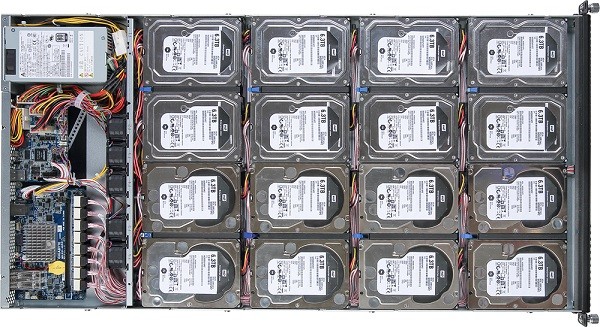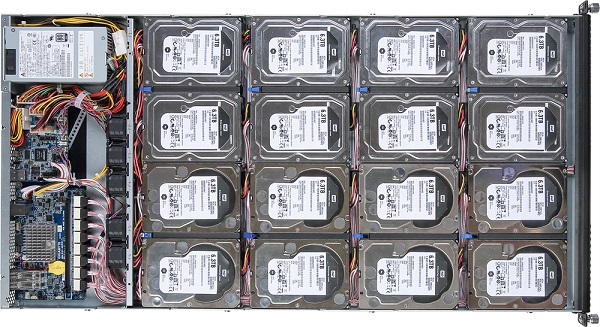Today Gigabyte released a new storage server based on the Annapurna ARM SoC. The Gigabyte D120-S3G is based on the Annapurna Alpine AL5140 quad-core 1.7GHz processor which provides a low power controller for up to 16 3.5″ disks in a 1U platform. The Annapurna Labs Alpine AL5140 is focused on a storage server platform.
High density 1U servers have become extremely popular in the last few years offering to have high density storage with low power processors providing basic storage management features. It is little secret that the basic NAS platform requires very little processing power unless there are higher-end features enabled. For getting massive amounts of storage online in a minimal footprint, these density optimized 1U servers have become extremely popular in a number of applications.
Gigabyte D120-S3G Specs
- Annapurna Alpine AL5140 quad-core 1.7GHz processor (ARM Cortex-A15)
- 1 x ECC DIMM slot
- 16 x 2.5″/3.5″ HDD/SSD slots, up to 100TB
- Supports SATA III 6Gb/s connections
- 2 x 10GbE SFP+ LAN ports (integrated)
- 2 x GbE LAN ports (Atheros® AR8035)
- 1 x 400W 80 PLUS Gold 100~240V AC PSU

One can see that the motherboard features 16x SATA ports as well as a small form factor and is very customized for this application allowing more hard drives to be packed into the 1U chassis.
Here is a bit more information from the Gigabyte D120-S3G Press Release:
Annapurna Labs Alpine AL5140 Processor
The D120-S3G is powered by the Annapurna Labs Alpine AL5140 1.7GHz Quad-Core processor, based on the ARMv7 architecture and the Cortex-A15 core. This chip has a power consumption of only 10 watts, which provides one of the highest performance per watt storage controller.Built-in Hardware Data Protection
Equipped with a dedicated hardware RAID and Erasure Code engine supporting RAID 5/6 levels protection, it forwards error correction from drive failures and thus spares CPU cycles from doing parity calculations or interfacing with the hard drives.An Optimized Solution Designed for Linux Environment
Using standard ARM Cortex-A15 cores ensures the compatibility with available software. The D120-S3G offers support for standard, Long Term Support (LTS) Linux Kernel 3.10 and Ubuntu 14.04. With over 1,000 Open Source software developing applications on ARM, the application ecosystem is mature and is able to support a wide range of applications for the enterprise.





This board is designed wrong. A15 is 32bit, with just one dimm slot, you can only have 4GB ram, driving 16 hard drives of 2-6TB each. Just metadata of the file system will overflow ram. But, guess what, it is great for Tim Nufire of Backblaze cause they don’t run ZFS.
Why not have an A57 chip with 4 dimms of DDR3L?
ARM doesn’t come near Intel’s performance so they have to win where lower prices are more important. That means that hardware RAID engine will probably not be very high-end and suck performance wise. This might make it into some low power “green” SOHO NAS offerings. But it needs 64bit, RDIMM and a whole lot of PCI-E lanes if it wants to make it big into the storage space.
The use case for this does not seem to be defined in the article. I would assume since it is a 32-bit cpu and a bunch of sata disks it would be used for backups, long-term storage, or some other archival. This would not be a good fit for high performance
Looks like those hard drives are going to get rather warm to me…
Might be able to pull enough air through to keep those drives within their temp spec, but you’d need some of those small high RPM fans, and those are going to use enough power to negate the ARM SoC…
Has anyone information on where to get a sample?
I’d like to test these with the new 8TB hard drives.
Perhaps these would make good building blocks for a cluster.
Lance – more info forthcoming this month (hopefully)